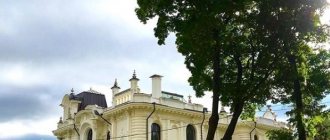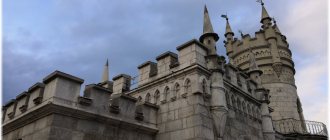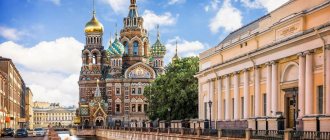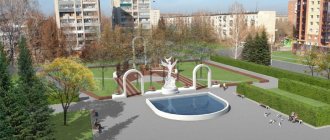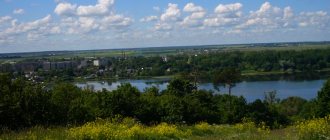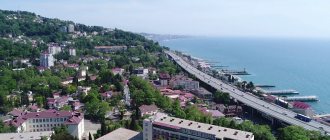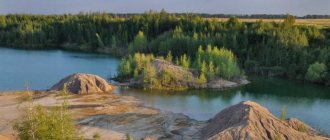Back in the 13th century, a fortress was built on the Slavyanka River to protect the borders of Veliky Novgorod. It was called Gorodok on Slavyanka. Catherine loved to go hunting in the local forests; in 1777, she gave these lands to her son Paul, and two houses were built here: for the Grand Duke himself - Paullust, for his wife - Marienthal.
In 1780, on the site of Paul's house, the architect Cameron erected the first palace of Pavlovsk. And the city was already growing around it: houses of the townspeople were being built, gardens and orchards were being cultivated. As soon as he ascended the throne, Paul ordered that the village of Pavlovskoye be considered the city of Pavlovsk. Today this city is part of St. Petersburg.
Pavlovsk Palace
Address: st. Sadovaya, 20 Phone: Website: https://pavlovskmuseum.ru/ Opening hours: 10.00-18.00 closed Friday (may vary depending on the season and weather conditions). Cost: adults: 250 rubles, pensioners: 120, schoolchildren: 100; Pink Pavilion: adults: 100 rubles, students: 50 rubles.
It was originally intended as a noble estate, but after the coronation, Emperor Paul decided to turn it into a summer palace. The palace was built over 50 years, the architects and sometimes the plans for its construction changed. Work on the construction of the palace began with Charles Cameron, and its interior decoration was completed by Voronikhin and Kvarneghi.
The palace at first was a typical noble estate, then Quarneghi turned it into a mansion with three floors and open galleries, then for the coronation of Paul the palace acquired a monumental appearance, for many years numerous galleries were added to the palace, and the architect Vicenzo Brenna also added a wing on each side .
After a fire in 1803, the palace was reconstructed. During the Great Patriotic War, the premises of the palace were looted.
Now the palace has been completely restored. There are 300 majestic, truly royal halls here, ready to receive guests.
Lifehacks for visitors
The easiest way to get to Pavlovsky Park is by train from the Kupchino platform. The journey will take approximately 20 minutes. It will take a little longer to get from Vitebsky station. From here you can get to Pavlovsk by any train.
Minibuses K299 and K545 go from Moskovskaya metro station to the park. But there is a danger of losing time by getting stuck in traffic.
The journey by car along the E95 highway will take about an hour. Drive past Pulkovo Airport, and then turn onto the Petersburg Highway, which turns into Pavlovskoye.
Pavlovsk. Photo: @_____olechka.o_____
The most important life hack
connected to the park entrance. You can save quite legally by arriving at the central gate before 10:00. At this time, you can go inside without a ticket. If getting up early is not in your plans, you can walk to the wild part of the park, which is not enclosed by a fence.
Although the park is very well maintained, there is minimal human intervention. You won't find cafes and souvenir shops at every turn. Therefore, it is worth taking water and a snack with you.
Pavlovsky Park
This is one of the largest landscape parks in our country, occupying 600 hectares of land. It is divided into seven landscape areas:
- Palace area - this includes the Own Garden, designed in the style of French and Dutch gardens; the center is a linden alley along which carriages drove up to the front porch. Large circles are carpet flower beds and tuff terraces; in the same area there is the famous Labyrinth, built from topiary bushes.
- The valley of the Slavyanka River is an area planted with silver willows and oaks, and there are also numerous plantings of dwarf bushy trees. There are cascades, spills and dams on the river; There are numerous bridges across the river: Gorbaty, Chugunny, Viskontiev and others.
- White Birch is an area designed by Pietro Gonzago in the style of a flat Russian park.
- Old Sylvia - this area is distinguished by a regular layout: here the paths, like rays, run in different directions from the central square.
- New Sylvia is an area of dense deciduous forest, in the thicket of which the Mausoleum of the benefactor spouse is hidden.
- Red Valley - among the ancient oaks and silver willows there are Ruins, artificial ancient ruins.
- Valley of Ponds - deep dark ponds surrounded by a wall of ancient trees.
The park has a large number of pavilions that harmoniously fit into the landscape. All pavilions are divided into two groups: memorial and classical.
The marble and bronze sculptures placed along the alleys of the park are of great artistic value. Bridges were built across the Slavyanka River, which flows here.
Mausoleum to the benefactor spouse
Address: Pavlovsky Park, New Sylvia district
A mausoleum was built in the depths of Pavlovsky Park. There is a dense and gloomy forest around it, the mausoleum was specially built here, in a place of loneliness and sadness, to emphasize its purpose.
Inside it there is a false tombstone (cenotaph), built by the architect I. Martos. Above the tombstone is a stone figure of a young woman, hugging in inescapable grief an urn containing the ashes of her beloved husband. This figure is a symbol of grief for all the dead.
Temple of Friendship
Address: Pavlovsky Park, Slavyanka River Valley area
The rotunda was designed and built by the architect Cameron. Concerts and intimate parties were held in this round building; next to the pavilion there was a small kitchen in the form of a hut, where food was prepared.
The pavilion is decorated only with modest bas-reliefs on the theme of love and friendship. The center of the rotunda is a statue of Catherine in the image of Caeceser. In the summer, the pavilion hosts exhibitions of sculpture from the museum's collections.
Pink Pavilion
Address: Pavlovsky Park, Belaya Bereza district
The romantic building of the architect Voronikhin is built of wood, but one gets the absolute impression that its walls are made of stone. It is surrounded by a magnificent rose garden, which gives the pavilion its name. But even inside it, everything was decorated with images of roses: lamps, vases, furniture, stucco on the ceiling and a huge service.
The harps built into the windows sound from the slightest breeze.
Poets, writers, and artists were received here. These walls remember Batyushkov, Zhukovsky, Karamzin.
Here Empress Maria Feodorovna met Alexander, her son, who had returned from Paris with victory over Napoleon. To make it possible to organize a reception in honor of this event, a special hall was added to the pavilion. This holiday went down in history.
Other entertainment
Squirrels are an unofficial attraction of Pavlovsk Park. Of course, they can be found not only here. But it is believed that the animals in this park are especially trusting and tame. If you bring some nuts with you, you can feed the Pavlovian squirrels
from the palm of your hand.
In the summer, you can rent a bicycle or Segway in the park and ride past the main attractions. There are also boat rentals and a trampoline. In winter, many people come here to ski or sled. And, of course, don't forget to take your camera with you. Even if a photo shoot was not part of your plans, it is difficult to resist taking a few photos in Pavlovsky Park.
Squirrel in Pavlovsky Park @pupsalinochka
Church of Mary Magdalene
Address: st. Sadovaya, 17 Telephone: Opening hours: 9.00-19.00
This Orthodox church was erected in 1784 with donations from Empress Maria Feodorovna as a court church by the architect Kvarneghi. For a long time, there was an almshouse, an orphanage, a hospital and a free pharmacy.
Military relics were kept in the church: captured banners and standards captured by the Russian army in its campaigns.
There are monuments here - cenotaphs (false tombstones) to Count Panin, Prince A. Burakin, tutor to Emperor Alexander Zagryazhsky. The last tombstone, in the form of a white marble mausoleum with a mourning woman, was built by the architect Marcos.
Currently it is a functioning temple.
Cathedral of St. Nicholas the Wonderworker
Address: st. Artilleriyskaya, 2 Telephone: Opening hours: 9.00-19.00
The temple was built in 1841, was a camp church of the Exemplary Cavalry Regiment and was originally made of wood. There was no heating and no permanent servants. The service was conducted by various local priests.
Then, by decree of Grand Duke Constantine, in place of the wooden temple, the architect Carboniere erected a stone one in the Russian style traditional for that time. It was illuminated in 1902 in the presence of the sovereign's family.
The church was closed in 1930, but in 1941 services in the temple resumed. After the end of the war, the temple was closed again, and only in 1991 it was transferred to the diocese.
The main artistic attraction of the church is the wooden iconostasis, it was made according to the sketches of the artist Subbotin.
Church of Catherine and the Nativity of the Blessed Virgin Mary
Address: Pavlovsky district, pos. Dynamo, st. Parkovaya, 1 Phone: Website: st-ekaterina.ucz.ru Opening hours: 9.00-19.00
The church in the style of Louis the Fourteenth, unusual for the Russian eye, was erected with the money of Count Martyn Skavronsky. It was rebuilt several times. In 1871 it was reconstructed, giving it its original appearance.
The temple is two-story: on the first floor there is the Church of the Great Martyr Catherine, on the second - the Church of the Nativity of the Blessed Virgin Mary. All gilded carved wooden iconostases were created according to the design of A.P. Bryullov, a Russian architect, the money for their creation was allocated by the well-known Countess Samoilova.
The complex is located in a picturesque location on a hill near the Slavyanka River, and it seems that the temple is floating above the plain.
At the beginning of the war, the bell tower was blown up to prevent the Germans from using it as a reference point for aiming guns. Now it has been almost completely recreated.
Currently ─ it is an active church; The ancient cemetery located nearby has many interesting tombstones.
Why it's worth a visit
The park is definitely worth a visit for those interested in history, and in particular, the period of the Romanov dynasty. Here, a huge number of monuments reminiscent of the times of the Russian Empire have remained virtually untouched. Also, while walking through the park, you can learn many interesting historical facts. In addition, Pavlovsky Park is perfect for photo shoots or family outings.
© Daria Gross
Pavlovsk Amusing Fortress (Bip Fortress)
Address: Nadgornaya st., 16
The fortress was built near the Slavyanka and Tyzva rivers on the site of the Marienthal house. Architect Quadri built a pleasure castle in two years, but according to all the rules of military fortification.
That is why the building was registered with the military department for a long time. Every evening the drawbridge was raised in the fortress and a cannon was fired, this continued until 1917. After the death of Emperor Paul, the first school in Russia for deaf and mute children was established in the castle.
In 1919, Yudenich's headquarters was located here. During the Great Patriotic War, the fortress was almost completely destroyed and was a stone box.
The name BIP is interpreted in different ways, one of these interpretations is: “Paul’s Big Toy.”
At the beginning of this century it was restored. Now there is a hotel and restaurant here.
What's interesting in Pavlovsk
The small town of the Leningrad region, in which the palace complex is located, was created for the residence of the Grand Duke and then Emperor Pavel Petrovich. It is located 25 km from the center of St. Petersburg, in the lowland between the left bank of the Neva River and the Slavyanka Valley.
Construction of the residence began in 1778 with the construction of 2 small houses:
- Paullusta (the emperor's chambers);
- Marienthal (wife's room).
Now in the city of Pavlovsk there are 42 architectural objects included in the UNESCO list of protected sites.
Pavlovsk is also beautiful in autumn.
Urban architecture
House with an angel
Address: st. Red Cadet 6/8
Initially, the house belonged to Vera, a court lady of Empress Maria Feodorovna. The Baryshnikov merchants, who later owned the house, collected a unique collection of Russian paintings and porcelain here; Igor Grabar, a famous Russian art critic, visited here.
Invalid home
Address: st. Prosveshcheniya, 3
Built in 1819 by Prince Kurakin. The facade of the building is decorated with a Doric portico, which has survived to this day. The house has been restored and has its original appearance.
Stein's dacha
Address: st. Sadovaya, 9
A unique mansion built in the Empire style.
Cast iron gates
Address: st. Sadovaya, 20
Built according to Rossi's design, they were the gateway to Pavlovsk. Emperor Nicholas ordered them to be built as a gift to his mother Maria Feodorovna.
Palace stables
Address: st. Konyushennaya, 2/11
Built according to the design of architects Brenn and Cameron for the stables of a cavalry regiment.
Train Station
Address: Station Square
The building was built in the Stalinist Empire style.
House of Pavlovsk Palace Administration
Address: Mariinskaya st., 6
Built according to the design of the Russian architect I. Potolov.


